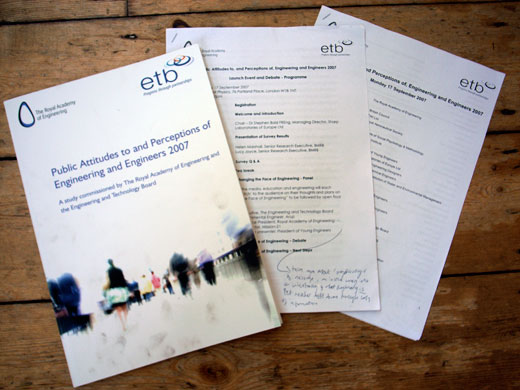Drivers of Engagement
On 17th September Andy and Tobie attended an the launch of a study into perceptions of engineering, at the Institute of Physics. The full title of the report is “Public Attitudes to and Perceptions of Engineering and Engineers”, with the research carried out by BMRB and jointly commissioned by the Royal Academy of Engineering and the Engineering and Technology Board. This is a fairly hefty report which mainly confirms in a statistical form what was already felt – that engineering is not very well understood (as a descriptive term and as a set of professions) by the general public, and by 16-19 year olds in particular. I can’t yet find a PDF of the report, but some details of the launch event are available here. This in itself is best considered in the light of a later comment from the floor by Lyndal Gully from the Science Media Centre, who asked for less press releases about detailed changes within the infrastructure of engineering institutes, and more news about engineering innovation.
The first part of the event saw key data from the report presented by researchers from BMRB, followed by some questions from the floor. Of interest for Material Beliefs was the empirical underlining of the role of online resources as an information source about engineers (see page 24 of the report) and some description of “Drivers of engagement” (page 32) – that is interesting, relevant and socially responsible issues. That there was nothing particularly surprising or insightful offered by the report is perhaps made up for that we now have something to point to when we talk about what we are doing, and why – and indeed in the course of the session it was described as a much needed “baseline”.
The second half of the programme saw some more personal testimonial about the theme of the report, with some concise deliveries on how to “Change the face of Engineering”. Of note was a passionate call for awareness of engineering’s impact and material ubiquity by Peter Wilkie of Arup. Particularly well chosen was his slide of a tailless dog, haplessly leaping a show-jump as a symbol of curtailed engineering graduates emerging into the world. This sentiment was later reinforced by Andrew Lamb from Engineering Without Borders, another relatively young attendee who is looking for changes in undergraduate syllabuses to link the practical and process based elements of engineering education to the social and ethical contexts that surround engineering. This would in fact drive an uptake in the discipline by making it relevant, as well as better preparing graduates for the demands of a career in an industry that has increasing demands for accountability and understanding within a broader and increasingly politicised society (“everyone has an opinion” we heard earlier from an assailed Scott Steedman).
I want to finish with another comment from the floor by Mark Miodownik who is based at KCL and also runs the magnificent Materials Library with Martin Conreen and Zoe Laughn. A recurring theme of the event was a collective dismay at the perceived sterility and inaction of engineering. Richard Knight offered a seductive case for how the design industry has stolen engineering’s thunder – the husk that we have been left with as the subject of this report into perceptions, might be reinvigorated by learning a few tricks from the designers, and gradually shifting the aura of the very work engineering so that it becomes a signifier of something more creative, ingenious, and er, cool. This marketing insight became moderated and refined by Mark’s comment, which had more in common with the frustrations “on the ground” that were felt by Peter and Andrew. That is, there is something to be changed in the way engineering is permitted to conduct itself, of the associations it makes with other forms of knowledge. Mark sees something exciting happening within art and design education which is absent from engineering – a playfulness, vitality and culture of creative experimentation. There was something entrenched and life-suckingly formal about the delivery of what should have been a blueprint for renewal that makes me agree. New drivers of engagement needed.

The report with additional inky finger marks on the cover